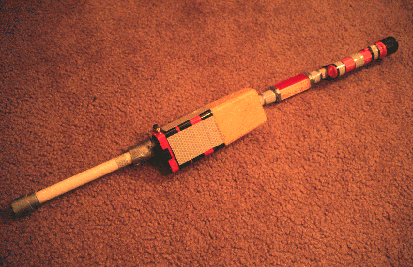
Displaying The Diver's Flag At Night
by
Larry "Harris" Taylor, Ph.D.
This is an
electronic reprint of an article that appeared in Sources (May/June, 1991, 51). This material is
copyrighted and all rights retained by the author. This article is made
available as a service to the diving community by the author and may be
distributed for any non-commercial or Not-For-Profit
use.
All rights reserved.
Go To: Home About "Harris" Articles Slides War Stories Editorials Links Fini
Most states require divers to mark their position under the
water with a diver's flag on the surface. At night, some form of illumination is
desirable. The trick is to inform people that a diving operation is in progress
without having every boater with too much body anti-freeze racing to your dive
flag to investigate. Since photochemical light sticks often attract boaters, we
no longer use them on the surface.
We mount the dive flag about 4 feet above the center of the
inner tube. For night diving, we drop a 1/2" x 24" piece of PVC pipe over the
flag shaft. The PVC tube helps stiffen the dive flag shaft and provides a
platform to mount a Tekna mini-light aimed upwards to illuminate the flag. Below
this is a yellow flashing strobe. (Made by painting the white portion of the
strobe with yellow model airplane paint.)
Since a white flashing strobe is an international distress signal, it is
inappropriate for divers to display on the surface in other than an emergency
situation. Yellow lights to the lay public mean caution and to knowledgeable
boaters a yellow light indicates a submerged operation. Although commercial and
educated boaters will most likely ignore a small flashing red, green or white
light on a float, some recreational boaters could mistake white, red or green
flashing lights as navigational markers or marina entrance buoys.
The extra space on the PVC shaft is filled with yellow bicycle
reflectors and pieces of 3 M marine reflecting tape. After the night dive, the shaft is
removed for convenient storage.
This
inexpensive, easy to prepare assembly (shown below) illuminates the dive flag
and provides a visible rally point for potential separated divers without
attracting boat traffic.

Dive Flag
Illumination Device
Go To: Home About "Harris" Articles Slides War Stories Editorials Links Fini
About The
Author:
Larry "Harris" Taylor, Ph.D. is a biochemist and Diving Safety
Coordinator at the University of Michigan. He has authored more than 200 scuba
related articles. His personal dive library (See Alert Diver, Mar/Apr, 1997, p.
54) is considered one of the best recreational sources of information In North
America.
All rights reserved.
Use of these articles for personal or organizational profit is specifically denied.
These articles may be used for not-for-profit diving education